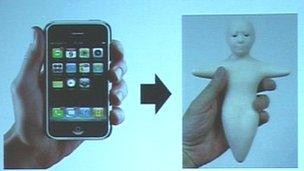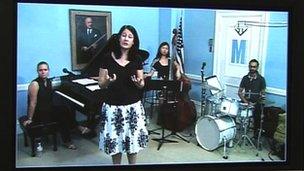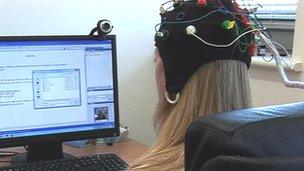Can avatars and hyper-real video conferencing replace business meetings?
- Published

The Telenoid R1 is described as a "tele-operated android"
With eery, childlike eyes staring out of a blank plastic face, the Telenoid R1 does not look like a serious tool for business.
Its movements are jerky. Limbs are conspicuously absent. And in terms of function, it is essentially just a $3000 video conferencing system, doing what Skype does for free.
But Professor Hiroshi Ishiguro of Osaka University believes his invention meets a real business demand, for hyper-realistic, face-to-face communication over long distances.
"Text communication is very limited, and so is normal video conferencing. But with the telenoid, you can actually feel the presence of another person."
Tricks of the mind

Ishiguro is working on a mobile 'elfoid'
Ishiguro's system uses a motion-tracking webcam to transmit your voice, facial expressions and head movements to the Telenoid, via a high-bandwidth web connection.
The avatar produces only a rough approximation of real body language, but it is surprisingly easy to dupe oneself into regarding it as 'human'.
"Eye contact and head movements are important for everybody. But we also gave the robot a minimal design, so that people can use their imagination to make it more personal", Ishiguro says.
Ishiguro believes that this mind-trickery could ultimately provide a return on investment, by allowing workers - interpreters, salespeople, teachers - to be in two places at once.
He is even developing a miniature version of the telenoid, the 'elfoid', which he hopes will one day rival ordinary mobile phones.
Greater bandwidth, greater illusion
Holding and touching a business colleague's avatar might be a step too far. But the real threat to the telenoid comes from a rival innovation that is already far more established.
Technology companies are making a fortune selling so-called 'telepresence suites', which exploit human psychology in a similar way to the telenoid.
Telepresence creates the illusion that separate video conferencing booths, located anywhere on the globe, are actually part of the same room.

Christiana Orto uses telepresence to teach her jazz students
Conference attendees are portrayed life-sized on high-definition screens, while room lighting and furnishings are carefully matched to enhance the effect.
Audio is high fidelity too, and the end result is a world away from the stuttery boardroom technology of old.
"Yes, it was used for boring boardroom conversations at one point in time. But for us, it is a way to reach out to students all over the globe", says music teacher Christianne Orto.
Orto works for the Manhattan School of Music, which uses Polycom telepresence suites in its concert hall and remote learning studios to give lessons to 1,700 international students each year.
Regardez mon visage
See the Telenoid R1 in action
Polycom has installed over a million telepresence suites, and its CEO Andy Miller forsees a drastic - and potentially worrying - expansion in their range of uses.
"We're at a tipping point now, because culturally people are accepting telepresence as a means of communication", he says.
"Soon you'll be able to visit your physician through a video kiosk."
"And you'll see kiosks in your local bank too, allowing you to talk to a branch manager or specialist who is based somewhere else."
It is easy to see how this technology could save banks money, not least by removing the very concept of a 'branch manager'. But it is harder to see how consumers will benefit.
Miller, though, does not believe this will be a sticking point.
"There will always be a place and a time for the in-person meeting. But we're making a difference in the world by giving people a choice. We call it 'location liberation'."
How much?
Less liberating is the price tag. In fact, telepresence makes Ishiguro's android look rather cheap.

James Campanini of Cisco explains telepresence - speaking via a video link
A telepresence suite can cost upwards of $300,000 to install, or $300 per hour to rent. That is a big outlay during the downturn - even if businesses can reduce travel expenses over time.
To convince more people to buy into the technology, Cisco Systems is trying to lower entry costs.
Its WebEx application allows telepresence suites to connect with computers and smartphones, so not all participants have to be in a suite.
"With one button you can bring someone up on the screen who is working from home or on their mobile at the airport", says Cisco's James Campanini.
"That's when the technology becomes really powerful."
A hat with wires

EEG caps were used to monitor subconscious changes during communication tasks
In a further effort to persuade customers, Campanini commissioned independent scientists to compare video chat against old-fashioned telephone conferencing and instant messaging.
The scientists used EEG electrode caps and other sensors to monitor things like stress and attentiveness.
The results?
Luckily for Campanini, video chat won the day. But the study also hints at how much productivity could be lost due to people's current reliance on text tools like IM, SMS and email.
No matter which new technology wins the battle for our eyeballs - telenoid or telepresence or something else - perhaps anything is better than depending on the written word.
"Stress levels with IM were really high", says Duncan Smith of MindLab International, who headed up the study.
"It's just too easy to misunderstand each other using text."